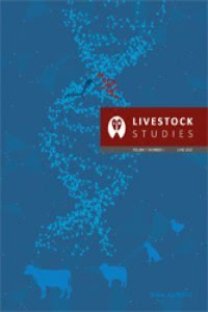PEKİN ÖRDEKLERİNDE ÇIKIMDAN SONRAKİ YEMLEME ŞEKLİNİN BÜYÜME, YAŞAMA GÜCÜ VE KESİM ÖZELLİKLERİNE ETKİSİ
Bu araştırmada, Pekin ördeklerinde çıkımdan hemen sonra yemlemenin büyüme, yaşama gücü ve kesim özelliklerine etkisi incelenmiştir. Araştırmada çıkımdan sonra yemleme gavajla (zorlamalı), kutuda ve rutin (kümeste yemleme) olmak üzere üç yöntemle yapılmıştır. Araştırmanın hayvan materyalini 32 haftalık Pekin ördeği (Grimaud Freres-STAR 53 H.Y) yumurtalarından elde edilen 360 adet palaz oluşturmuştur. 7, 21, 35 ve 49. günlerde canlı ağırlık değerleri G grubunda 242.48; 1376.31; 2654.49 ve 3445.65g, K grubunda 266.67; 1394.46; 2657.26 ve 3463.78 g, T grubunda 265.11; 1448.04; 2703.10 ve 3389.69 g, erkek grubunda 262,79; 1407.69; 2689.97 ve 3475.96 g, dişi grubunda 253.38; 1404.86; 2653.27 ve 3390.12 g olmuştur. Yaşama gücü ilk hafta tüm gruplarda % 99.04; 4. hafta G grubunda % 98.85; K ve T gruplarında % 100; 8. hafta G grubunda % 97.44; K grubunda % 100; T grubunda % 98.73; erkeklerde G, K, T gruplarında ilk hafta % 100; 100; 98.08; dördüncü hafta % 97.73; 100; 100; sekizinci hafta % 94.87; 100; 100, dişilerde aynı sıra ile % 98.08; 98.08 ve 100; dördüncü hafta % 100; % 100; % 100; sekizinci hafta % 100, % 100, % 97.50 olmuştur. Büyüme döneminde genel olarak K ve T grupları benzer G grubu en düşük değer göstermiştir. Kesim ağırlığı, sıcak karkas ağırlığı, soğuk karkas ağırlığı, sıcak karkas randımanı, soğuk karkas randımanı ve soğutma firesine ait değerler G grubunda 3139.01; 2352.36; 2305.14 g; % 74.45; 72.93 ve 2.04; K grubunda 3155.41; 2404.64; 2338.70 g; % 76.19; 74.11 ve 2.71; T grubunda 3078.72; 2325.16; 2276.69 g; % 75.39; 73.89 ve 2.01; erkek grubunda 3125.13; 2368.73; 2322.95g; %75.57; 74.16 ve 1.88; dişi grubunda 3123.63; 2352.71; 2290.73; % 75.11; 73.14 ve 2.63 olmuştur. Sonuç olarak, Pekin ördeği yetiştiriciliğinde çıkımdan hemen sonra gavajla yemleme uygulamasının ticari işletmelere bir avantaj sağlamadığı ve uygulanmakta olan yemleme tipinin (kümeste yemleme) Pekin ördekleri için en iyi yöntem olduğu tespit edilmiştir.
Anahtar Kelimeler:
Pekin ördeği, Büyüme, Yaşama gücü, Kesim özellikleri.
The Effects of Immediately Feeding After Hatching on Growth, Viability and Slaughter Characteristics in Pekin Ducks
This study was designed to investigate the hypothesis that the feeding immediately after hatching have effect on the post hatching growth, livability and slaughter characteristics. After hatching, feeding to be done in three method: gavage (force-feeding), box feed and standard (routine). A total of 360 (180 male, 180 female) ducklings were obtained from a 32 week old Pekin duck breeder flock (Grimaud Freres-STAR 53 H.Y). Body weights on days 7, 21, 35 and 49 for G group were 242.48; 1376.31; 2654.49 and 3445.65g; for K group were 266.67; 1394.46; 2657.26 and 3463.78 g; for T group were 265.11; 1448.04; 2703.10 and 3389.69 g; for male group 262.79; 1407.69; 2689.97 and 3475.96 g; for female group 253.38; 1404.86; 2653.27 and 3390.12 g, respectively. Livability was % 99.04 in all groups for the first week; on week 4 for G group was % 98.85; K and T groups were % 100; on week 8 for G group was % 97.44; for K group was % 100; for T group was % 98.73. Livability for male group on week 1 in G, K and T groups % 100, 100 and 98.08; on week four % 97.73; 100 and 100; on week eight % 94.87; 100 and 100 respectively. Livability for female group on week 1 in G, K and T groups % 98.08; 98.08 and 100; on week four % 100; % 100 and % 100; on week eight % 100, 100 and 97.50 respectively. The period of growth K and T groups were equal value and group G was lowest value for livability. Slaughter weight, hot carcass weight, cold carcass weight, hot carcass yield, cold carcass yield and cooler shrinkage for G group were 3139.01; 2352.36; 2305.14 g; % 74.45; 72.93 and % 2.04; for K group were 3155.41; 2404.64; 2338.70 g; % 76,19; 74.11 and % 2.71; for T group were 3078.72; 2325.16; 2276.69 g; % 75.39; 73.89 and 2.01; for male group were 3125.13; 2368.73; 2322.95g; % 75.57; 74.16 and % 1.88; for female group were 3123.63; 2352.71; 2290.73; %75.11; 73.14; % 2.63 respectively. Conclusion of this study that feeding immediately after hatching was not provide an advantage in commercial enterprises. It is recommended that being feed applied (routine) method is the best method in Pekin ducks
Keywords:
Pekin Duck, Growth, Viability, Slaughter characteristics.,
- Yayın Aralığı: Yılda 2 Sayı
- Başlangıç: 1959
- Yayıncı: Sezer ÖZ
Sayıdaki Diğer Makaleler
Özlem Gücüyener HACAN, Halil AKÇAPINAR
MANDALARDA MASTİTİS VE SÜT VERİMİNE ETKİSİ (DERLEME)
